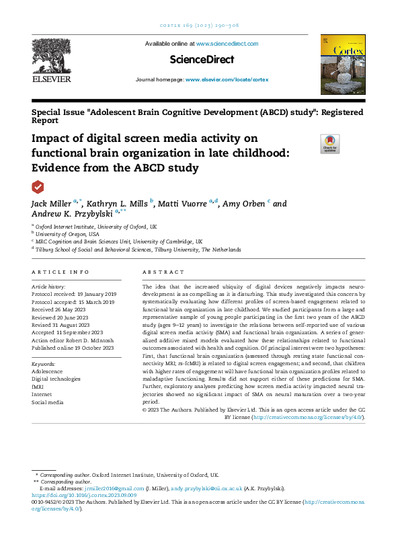 Dieses Biblionetz-Objekt existiert erst seit Dezember 2023. Es ist deshalb gut möglich, dass viele der eigentlich vorhandenen Vernetzungen zu älteren Biblionetz-Objekten bisher nicht erstellt wurden. Somit kann es sein, dass diese Seite sehr lückenhaft ist.
Dieses Biblionetz-Objekt existiert erst seit Dezember 2023. Es ist deshalb gut möglich, dass viele der eigentlich vorhandenen Vernetzungen zu älteren Biblionetz-Objekten bisher nicht erstellt wurden. Somit kann es sein, dass diese Seite sehr lückenhaft ist. Zusammenfassungen
Zusammenfassungen
The impact of screen engagement on neurodevelopment in
children and adolescents has been a topic of much inquiry.
We examined how screen engagement relates to functional
brain connectivity in a large sample of U.S. children between
ages 9e12 years. While patterns of functional brain connectivity
were related to pattern of screen engagement, we found
no meaningful associations between overall profiles and
measures of cognitive and mental wellbeing, even if we set the
evidential threshold very low. Overall, this study does not
support policies centered around limiting screen time to
protect neurocognitive development.
Von Jack Miller, Kathryn L. Mills, Matti Vuorre, Amy Orben, Andrew K. Przybylski im Text Impact of digital screen media activity on functional brain organization in late childhood (2023) The idea that the increased ubiquity of digital devices negatively impacts neurodevelopment is as compelling as it is disturbing. This study investigated this concern by systematically evaluating how different profiles of screen-based engagement related to functional brain organization in late childhood. We studied participants from a large and representative sample of young people participating in the first two years of the ABCD study (ages 9–12 years) to investigate the relations between self-reported use of various digital screen media activity (SMA) and functional brain organization. A series of generalized additive mixed models evaluated how these relationships related to functional outcomes associated with health and cognition. Of principal interest were two hypotheses: First, that functional brain organization (assessed through resting state functional connectivity MRI; rs-fcMRI) is related to digital screen engagement; and second, that children with higher rates of engagement will have functional brain organization profiles related to maladaptive functioning. Results did not support either of these predictions for SMA. Further, exploratory analyses predicting how screen media activity impacted neural trajectories showed no significant impact of SMA on neural maturation over a two-year period.
Von Jack Miller, Kathryn L. Mills, Matti Vuorre, Amy Orben, Andrew K. Przybylski im Text Impact of digital screen media activity on functional brain organization in late childhood (2023)  Dieser wissenschaftliche Zeitschriftenartikel erwähnt ...
Dieser wissenschaftliche Zeitschriftenartikel erwähnt ...
 Personen KB IB clear | Christopher J. Ferguson, Amy Orben, Andrew K. Przybylski | |||||||||||||||||||||||||||
 Begriffe KB IB clear |  Digitalisierung, Digitalisierung,  Gehirn Gehirn brain, Hypothesehypothesis, brain, Hypothesehypothesis,  Kinder Kinder children, Prognose children, Prognose | |||||||||||||||||||||||||||
 Texte |
|
 Dieser wissenschaftliche Zeitschriftenartikel erwähnt vermutlich nicht ...
Dieser wissenschaftliche Zeitschriftenartikel erwähnt vermutlich nicht ... 
 Zitationsgraph
Zitationsgraph
 Anderswo finden
Anderswo finden
 Volltext dieses Dokuments
Volltext dieses Dokuments
 |  Impact of digital screen media activity on functional brain organization in late childhood: Artikel als Volltext ( Impact of digital screen media activity on functional brain organization in late childhood: Artikel als Volltext ( : :  , 4022 kByte; , 4022 kByte;  : :  ) ) |
 Anderswo suchen
Anderswo suchen 
 Beat und dieser wissenschaftliche Zeitschriftenartikel
Beat und dieser wissenschaftliche Zeitschriftenartikel
Beat hat Dieser wissenschaftliche Zeitschriftenartikel erst in den letzten 6 Monaten in Biblionetz aufgenommen. Er hat Dieser wissenschaftliche Zeitschriftenartikel einmalig erfasst und bisher nicht mehr bearbeitet. Beat besitzt kein physisches, aber ein digitales Exemplar. Eine digitale Version ist auf dem Internet verfügbar (s.o.). Aufgrund der wenigen Einträge im Biblionetz scheint er es nicht wirklich gelesen zu haben. Es gibt bisher auch nur wenige Objekte im Biblionetz, die dieses Werk zitieren.












 Biblionetz-History
Biblionetz-History